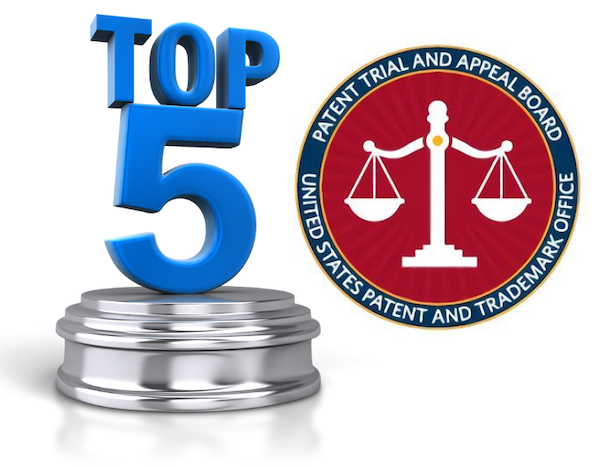“With proposed legislation circulating, and growing dissatisfaction with the USPTO, 2022 may have significant changes in store for the Patent Trial and Appeal Board.”
 Noteworthy 2021 developments at the Patent Trial and Appeal Board (PTAB) were primarily driven by oversight—via the United States Patent and Trademark Office (USPTO) Director, Supreme Court and Federal Circuit—rather than by new rules or policy of the agency. After the highly anticipated Arthrex decision fizzled at the Supreme Court, the most significant 2021 development may be former Director Iancu’s departure and legacy of decidedly pro-patent owner policies. That legacy is increasingly under attack. From the Biden administration’s nomination of a new director, to legislative proposals, to Congressional pushback on Section 314(a) discretionary denials of institution (especially as they relate to the Western District of Texas), to lawsuits challenging the practice as an Administrative Procedures Act violation, change is afoot. The coming year is sure to see recalibration of current PTAB practices.
Noteworthy 2021 developments at the Patent Trial and Appeal Board (PTAB) were primarily driven by oversight—via the United States Patent and Trademark Office (USPTO) Director, Supreme Court and Federal Circuit—rather than by new rules or policy of the agency. After the highly anticipated Arthrex decision fizzled at the Supreme Court, the most significant 2021 development may be former Director Iancu’s departure and legacy of decidedly pro-patent owner policies. That legacy is increasingly under attack. From the Biden administration’s nomination of a new director, to legislative proposals, to Congressional pushback on Section 314(a) discretionary denials of institution (especially as they relate to the Western District of Texas), to lawsuits challenging the practice as an Administrative Procedures Act violation, change is afoot. The coming year is sure to see recalibration of current PTAB practices.
1) Iancu’s Legacy
Former USPTO Director Andrei Iancu made many pro-patent owner changes to the agency during his nearly three-year tenure. Examples of policy changes include:
- Greatly expanding the use of discretionary denials under 314(a);
- Establishing a Precedential Opinion Panel (POP) for the Director to drive agency policy;
- Changing the Board’s claim construction standard from the Broadest Reasonable Interpretation to the Philips standard used in district court;
- Adding patent owner sur-reply briefing in place of discretionary Motions for Observation;
- Giving patent owners the opportunity to present a sur-rebuttal at oral argument;
- Creating a pilot program to aid patent owners in amending claims during America Invents Act (AIA) trials;
- Providing pro-patent § 101 examination guidelines;
- Applying the more liberal Nautilus 112 standard for AIA trials; and
- Limiting the use of Applicant Admitted Prior Art in AIA trials.
Of all these changes, the most impactful—and controversial—was extending Section 314(a) discretion to consideration of parallel litigation proceedings. By giving significant weight to district court trial schedules that were often unrealistically set, inter partes review (IPR) institution rates dropped 15-20%. Unsurprisingly, the practice has faced a backlash from patent challengers.
2) Pushback on Section 314(a) Discretionary Denial Practice
Iancu’s expansion of discretionary denials has faced challenges on all sides. A number of large tech companies filed a suit challenging the 314(a) discretionary denial practice as a violation of the Administrative Procedure Act due to a lack of notice and comment rulemaking. While the district court recently dismissed the suit as an impermissible challenge to a Director’s institution decision under Cuozzo, left unanswered is the overall practice relative to APA requirements of Notice and Comment Rulemaking relative to the “shenanigans” mentioned in Cuozzo. This issue may be more fully addressed on appeal.
- Plaintiff’s concerns on Section 314(a) are shared by Congress. A recent bipartisan legislative proposal from Senator Leahy – (D-VT) and Senator Cornyn – (R-TX) entitled “Restoring the America Invents Act” (RAIA) overrules the practice while rebuking other Iancu-era policies (as discussed in detail below).
- In tandem, Senators Tillis and Leahy have attacked scheduling and venue practices in WDTX, as well as Judge Albright’s hold on a growing percentage (27% at writing) of the nation’s patent docket. In a November 2021 letter to Chief Justice Roberts, Senator Leahy and Tillis – (R-NC) requested that the Judicial Conference investigate Western District of Texas (WDTX) venue practices and provide a report to the Senate Judiciary Committee by May 1. The letter characterized WDTX practices as “unseemly and inappropriate.” In communicating to the USPTO on the same topic, Senator Tillis pointed out that WDTX scheduling orders are aggressive and “unrealistic,” and that the PTAB should instead look to the average time to trial.
3) Arthrex Fizzles
The lone Supreme Court decision involving the PTAB this term started as an existential threat to the AIA and ended up being little more than an academic exercise. The issue in United States v. Arthrex, Inc. was whether the Board’s administrative patent judges (APJs) were constitutionally appointed and, if not, whether a judicial cure was possible to avoid invalidating every AIA trial decision. Despite finding APJs were wielding the authority of a principal officer without a constitutional appointment, the Court refused to invalidate all AIA trial decisions. Instead, the Court merely required the agency provide a path to Director review of all PTAB decisions. In response to Arthrex, the agency simply set-up a second rehearing path to the Director. A legislative tweak to codify the Arthrex decision has been proposed in the draft RAIA.
4) Bipartisan ‘Restoring the America Invents Act (RAIA)’
As noted above, Senators Leahy and Cornyn have introduced legislation to revamp the AIA and overturn nearly all changes made by former Director Iancu. In addition to abrogating discretionary denial practices under 314(a) and implementing Arthrex, the proposed legislation, (among other things):
- Adds Obviousness-Type Double Patenting to the grounds for IPRs and PGRs;
- Overrules Click-to-Call’s holding that the IPR time bar provision is invoked by litigation that is dismissed without prejudice;
- Encourages stays of district court litigation pending IPRs by adding a factor in favor of stays and interlocutory review of stay denials;
- Shifts the burden to the patentee to prove the patentability of amended claims (thereby overruling Aqua Products);
- Requires the issuance of a certificate cancelling claims within 60 days of an appeal decision or abandonment;
- Presumes an injury in fact based on estoppel from a final written decision for purposes of standing on appeal;
- Permits filing of IPRs and post grant reviews (PGRs) by the U.S. government; and
- Overrules the exception to estoppel for joined parties.
While the bill is unlikely to pass its current form, the enactment of even a select few items from this proposal would have significant effects on the patent litigation landscape. Given the bill has bipartisan support, and is argued as affecting drug pricing for consumers in a critical mid-term election year, it seems likely that some aspect of the RAIA will pass into law in 2022. Keep in mind that Senator Leahy (namesake of the AIA) is also retiring in 2022. Since the RAIA may be his legislative swan song, I expect a significant push in the months ahead.
5) Important, but Niche, Issues Decided by the Federal Circuit
As evidenced by its placement on this review, the biggest issues decided by the Federal Circuit involving the PTAB this year were relatively niche. The Federal Circuit weighed in on joinder estoppel, standing on appeal from PTAB decisions, more due process challenges to the AIA, the impact of NDA forum selection clauses on IPRs, and the availability of ex parte reexamination post-IPR.
- Joinder estoppel: A party joined to a first petition challenging certain patent claims is not estopped under 315 from challenging other claims in a later petition because (1) the party could not raise grounds in the original petition and (2) the other claims were not decided in a final written decision. Uniloc 2017 LLC v. Facebook Inc., 989 F.3d 1018, 1030-31 (Fed. Cir. 2021). (But note, RAIA would overturn).
- Standing: A party that licenses a patent challenged at the PTAB lacks standing to appeal a PTAB decision where the challenge does not affect its contract rights under the license and fails to identify a concrete risk of a lawsuit involving the patent. Apple Inc. v. Qualcomm Inc., 992 F.3d 1378 (Fed. Cir. 2021). (Subject to SCOTUS review)
- Due Process: The USPTO’s interest in fee generation and APJs alleged financial interests in instituting AIA trials do not constitute due process violations. Mobility Workx, LLC v. Unified Patents, LLC, 15 F.4th 1146, 1153-56 (Fed. Cir. 2021).
- NDA forum selection clauses: A forum selection clause in an NDA cannot be used to prohibit a party to the agreement from seeking an IPR absent specific language. Kannuu PTY Ltd. v. Samsung Elecs. Co., 15 F.4th 1101, 1105 (Fed. Cir. 2021).
- Ex Parte reexamination petitions post-IPR filing: Ex Parte reexamination proceedings may not be available to parties that have previously filed serial IPR petitions to advance the same arguments. In re Vivint, Inc., 14 F.4th 1342, 135154 (Fed. Cir. 2021)
Prospects for the Year Ahead
Overall, 2021 was a bit of a slow year for big decisions and news involving the PTAB. With proposed legislation circulating, and growing dissatisfaction with the USPTO, 2022 may have significant changes in store. Or, like Arthrex, the promises to overhaul the system may fail to live up to expectations.

![[IPWatchdog Logo]](https://ipwatchdog.com/wp-content/themes/IPWatchdog%20-%202023/assets/images/temp/logo-small@2x.png)

![[Advertisement]](https://ipwatchdog.com/wp-content/uploads/2024/04/UnitedLex-May-2-2024-sidebar-700x500-1.jpg)
![[Advertisement]](https://ipwatchdog.com/wp-content/uploads/2024/04/Artificial-Intelligence-2024-REPLAY-sidebar-700x500-corrected.jpg)
![[Advertisement]](https://ipwatchdog.com/wp-content/uploads/2024/04/Patent-Litigation-Masters-2024-sidebar-700x500-1.jpg)

![[Advertisement]](https://ipwatchdog.com/wp-content/uploads/2021/12/WEBINAR-336-x-280-px.png)
![[Advertisement]](https://ipwatchdog.com/wp-content/uploads/2021/12/2021-Patent-Practice-on-Demand-recorded-Feb-2021-336-x-280.jpg)
![[Advertisement]](https://ipwatchdog.com/wp-content/uploads/2021/12/Ad-4-The-Invent-Patent-System™.png)






Join the Discussion
2 comments so far.
Anon
December 28, 2021 07:36 pmOne recommendation: short of having the old comments count feature, have a “new comments” indicator to the various posts (perhaps on a daily basis).
Anon
December 28, 2021 03:12 pmI have to say: my first impression with the new format is not a positive one.
Maybe it will grow on me….